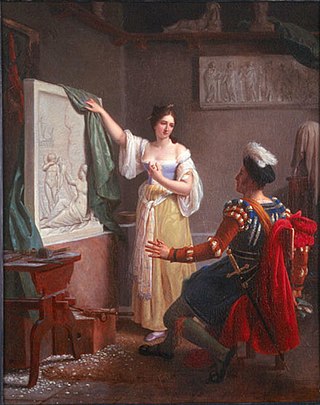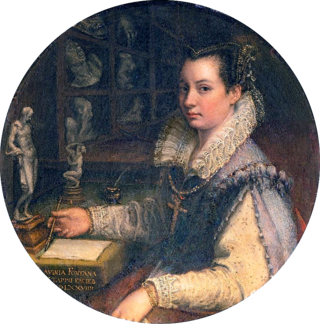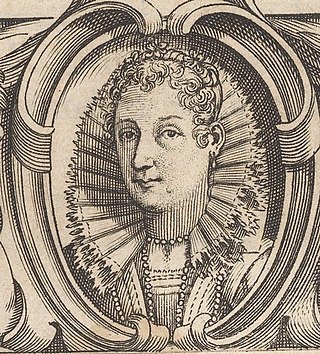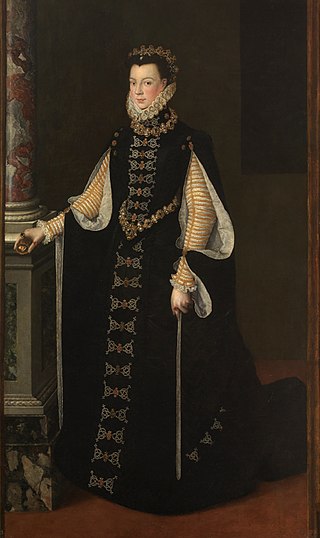
Sofonisba Anguissola, also known as Sophonisba Angussola or Sophonisba Anguisciola, was an Italian Renaissance painter born in Cremona to a relatively poor noble family. She received a well-rounded education that included the fine arts, and her apprenticeship with local painters set a precedent for women to be accepted as students of art. As a young woman, Anguissola traveled to Rome where she was introduced to Michelangelo, who immediately recognized her talent, and to Milan, where she painted the Duke of Alba. The Spanish queen, Elizabeth of Valois, was a keen amateur painter and in 1559 Anguissola was recruited to go to Madrid as her tutor, with the rank of lady-in-waiting. She later became an official court painter to the king, Philip II, and adapted her style to the more formal requirements of official portraits for the Spanish court. After the queen's death, Philip helped arrange an aristocratic marriage for her. She moved to Sicily, and later Pisa and Genoa, where she continued to practice as a leading portrait painter.

Properzia de' Rossi was a ground-breaking female Italian Renaissance sculptor and one of only four women to receive a biography in Vasari's Lives of the Artists.

Lavinia Fontana was an Italian Mannerist painter active in Bologna and Rome. She is best known for her successful portraiture, but also worked in the genres of mythology and religious painting. She was trained by her father Prospero Fontana who was a teacher at the School of Bologna. She is regarded as the first female career artist in Western Europe as she relied on commissions for her income. Her family relied on her career as a painter, and her husband served as her agent and raised their 11 children. She was perhaps the first female artist to paint female nudes, but this is a topic of controversy among art historians.
Events from the year 1528 in art.

Sister Plautilla Nelli (1524–1588) was a self-taught nun-artist and the first ever known female Renaissance painter of Florence. She was a nun of the Dominican convent of St. Catherine of Siena located in Piazza San Marco, Florence, and was heavily influenced by the teachings of Savonarola and by the artwork of Fra Bartolomeo.
Events from the year 1625 in art.
Caterina Ginnasi was an Italian noblewoman and painter of the Baroque period, active mainly in Rome.
Events from the year 1530 in art.
Events from the year 1550 in art.
Angelica or Angiola Veronica Airola was an Italian painter of the Baroque period, active mainly in 17th century Genoa. She was a pupil of the painter Domenico Fiasella. She became a nun of the order of San Bartolommeo dell' Oliveta at Genoa. She painted several works, mainly religious, while in the convent.
Mariangiola Criscuolo was an Italian painter of the Renaissance period, active mainly in her native city of Naples. She is known for portraiture and history painting, and excelled in painting altarpieces. She was also involved in the foundation of one of the first female-organized schools of art during the sixteenth century.
Caterina Tarabotti was an Italian painter of the Baroque period. She was born in Venice, and a pupil of Alessandro Varotari, called Padovino, (1588-1649) and his sister Chiara. The sister of proto-feminist writer Arcangela Tarabotti, she practiced chiefly in Vicenza, where she painted historical pictures. She died in financial constraints at the Ospedaletto di San Giobbe in Venice on 8 February 1693, aged 78.

Isabella Parasole was an Italian engraver and woodcutter of the late-Mannerist and early-Baroque periods.

Eufrasia Burlamacchi (1482–1548) was an Italian nun who practiced the art of manuscript illumination.
Maria Angelica Razzi was an Italian sixteenth century nun and sculptor at Santa Caterina da Siena in Florence. She primarily worked in clay to make devotional terracotta figures.

Portrait of Elisabeth of Valois is an oil-on-canvas painting executed c.1561–1565 by the Italian artist Sofonisba Anguissola, now in the Museo del Prado in Madrid.

Portrait of Massimiliano II Stampa is a c.1558 oil-on-canvas painting by the Italian Renaissance painter Sofonisba Anguissola, now in the Walters Art Museum, Baltimore, USA. It was previously misattributed to Giovan Battista Moroni, possibly due to stylistic similarities with Moroni's The Knight in Black.








